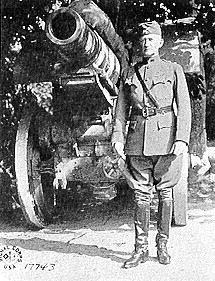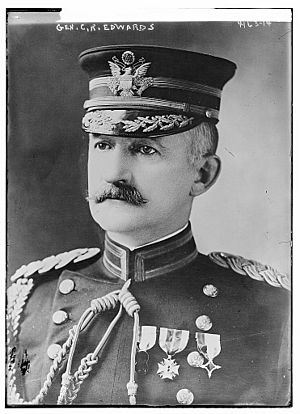Clarence Ransom Edwards facts for kids
Quick facts for kids
Clarence Ransom Edwards
|
|
|---|---|
 |
|
| Born | January 1, 1859 Cleveland, Ohio, United States |
| Died | February 14, 1931 (aged 72) Boston, Massachusetts, United States |
| Buried | |
| Allegiance | |
| Service/ |
|
| Years of service | 1883–1922 |
| Rank | |
| Service number | 0-36 |
| Unit | |
| Commands held | 6th Brigade 1st Hawaiian Brigade 26th Division |
| Battles/wars | Spanish–American War Philippine–American War World War I |
| Awards | Distinguished Service Medal Silver Star (3) Philippine Campaign Medal World War I Victory Medal Légion d'honneur (France) Croix de guerre (France) Order of Leopold (Belgium) |
Major General Clarence Ransom Edwards (born January 1, 1859 – died February 14, 1931) was an important officer in the United States Army. He is known for being the first chief of the Bureau of Insular Affairs. He also commanded the 26th Division during World War I.
Contents
Early Military Life
Edwards was born in Cleveland, Ohio. His father, William Edwards, was a local merchant. Clarence graduated from the United States Military Academy in 1883.
After West Point, Edwards became a second lieutenant in the Infantry Branch. He served at various military posts. These included Fort Union and Fort Porter. At Fort Porter, he met Bessie Rochester Porter. They got married in 1889.
He was promoted to first lieutenant in 1891. At that time, he was teaching military science at St. John's College (now Fordham University). He later returned to his regiment as a captain. He commanded a rifle company and also worked as a quartermaster.
Wars and New Roles
When the Spanish–American War began, Edwards moved with his regiment. In May 1898, he became a major in the U.S. Volunteers. He served as Adjutant General for the 4th Army Corps. This corps was supposed to invade Cuba but could not get transport.
In January 1899, Edwards went to the Philippines. He joined General H. W. Lawton's staff. He fought in Lawton's campaigns there. These included the Battle of Santa Cruz and the Battle of Zapote Bridge. Edwards earned three silver citation stars for his bravery.
After General Lawton died, Edwards returned to Washington, D.C.. In 1900, he became a lieutenant colonel. He was put in charge of the Division of Customs and Insular Affairs in the War Department. In 1902, he became a colonel and the first chief of the new Bureau of Insular Affairs. He held this job until 1912, when he became a brigadier general.
Edwards then commanded the 6th Brigade in Wyoming. In 1913, his brigade moved to Texas City, Texas. This was because of the Mexican Revolution. From 1914 to 1917, he commanded troops in Hawaii and the Panama Canal Zone.
World War I Service
When World War I started, Edwards was put in charge of the Northeastern Department. This covered all the New England states. In August 1917, he was promoted to major general. He was given the job of organizing the 26th Division.
This division was made up of Army National Guard soldiers. It arrived on the Western Front in September 1917. It was the first full American division to reach the front. The 26th Division was also the first American division to fight in combat. This happened at Chemin-des-Dames, France, in February 1918.

Edwards was known for speaking his mind. General John J. Pershing, who led the American forces, did not like him. Edwards also had a disagreement with Major General Robert Lee Bullard. This happened when the 26th Division took over from another division in April 1918.
Edwards was removed from his command in October 1918. He had reported that some of his soldiers talked with German soldiers. The Germans said the war would end soon and they did not want to fight. Edwards thought he was reporting enemy morale. But General Pershing used this as a reason to remove him.
After the War
After returning to the United States, Edwards again commanded the Northeastern Department in Boston. In 1920, he went back to his regular rank of brigadier general. He then commanded the 2nd Brigade in Kentucky.
In June 1921, he became a major general again. He commanded the First Corps Area in Boston. He retired on December 1, 1922, after almost 40 years of service. After retiring, Edwards became president of his father's grocery company.
Edwards was also a member of the Military Order of Foreign Wars. He served as its Commander General from 1923 to 1926.
His daughter Bessie died in 1918, and his wife died in 1929. Edwards passed away on February 14, 1931, in Boston, Massachusetts. All three are buried together at Arlington National Cemetery.
Honors and Awards
Military Decorations and Medals
- Distinguished Service Medal (given after his death in 1937)
- Spanish War Service Medal
- Philippine Campaign Medal with three silver citation stars
- Victory Medal
- Legion of Honor (France)
- Croix de Guerre with palm (France)
- Grand Cross Order of Leopold (Belgium)
- Haller Swords (Poland)
Other Honors
- Edwards received honorary Doctor of Laws degrees from several universities. These included Syracuse University, Trinity College, Middlebury College, Boston College, Norwich College, and Fordham College.
- His important papers are kept at the Massachusetts Historical Society in Boston.
Legacy
- A middle school in Charlestown, Massachusetts, is named after him.
- A statue of Edwards stands at the Connecticut State Capitol.
- The General Edwards Bridge carries Massachusetts Route 1A into Lynn, Massachusetts.
- Edwards Parade is located on the campus of Fordham University.
- Camp Edwards, a training camp for the Massachusetts National Guard in Falmouth, Massachusetts, was named for him in 1938.
- There is a monument to Edwards in Rutland, Vermont. It was put there in 1934 by the 26th "Yankee" Division.
- General Edward's evening dress uniform is in the museum collection of the Ancient and Honorable Artillery Company of Massachusetts.
Images for kids
-
Statue of Major General Clarence Ransom Edwards at the Connecticut State Capitol in Hartford, Connecticut.




